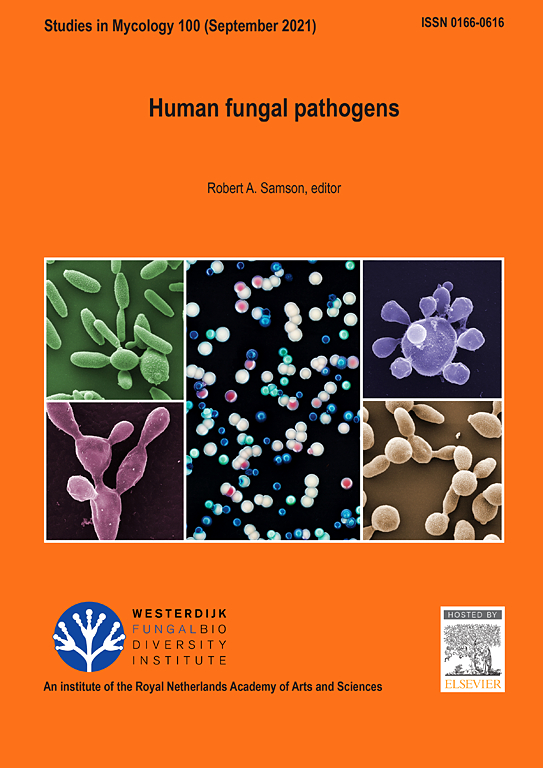疫霉属的分类和系统发育修正
IF 14.1
1区 生物学
Q1 MYCOLOGY
引用次数: 0
摘要
疫霉菌属的许多成员在苗圃、园艺、森林和自然生态系统中引起经济和环境影响疾病,许多成员在世界范围内受到监管关注。目前,有223个被描述的物种,包括8个不可培养的物种和3个消失的物种。28个物种需要重新描述或验证。对20个种进行了选型、表型和新型分析,并根据形态/分子特征和系统发育定位对其进行了重新描述。此外,还验证了五个物种的名称:P. cajani, P. honggalleglyana(同义:P. hydropathica), P. megakarya, P. pisi和P. pseudopolonica,并给出了形态和系统发育。P. ×multiformis和P. uniformis作为新组合提出。棕榈疫霉用一种有代表性的菌株进行处理,因为两者的凝集和典型化都有待解决。本文提供了更新的多基因系统发育和分子工具箱,其中包括从212个有效发表的模式标本和可培养物种(包括9个杂交分类群)中生成的7个基因(ITS rDNA, β-tub, COI, EF1α, HSP90, L10和YPT1)。还包括迄今已发表的23种类型的基因组信息。本文讨论了该属的分类修订和系统发育重新评价的几个方面,包括种概念、在疫霉菌中发现的系统发育分支的概念和位置。该手稿的部分内容,包括212个物种的情况说明书,与“IDphy:基于类型的疫霉分子和形态学鉴定”在线资源(https://idtools.org/tools/1056/index.cfm)有关。2019年9月向公众发布的第一版IDphy在线资源包含161个物种。与此同时,我们正在将IDphy在线资源更新到第2版,以包括最近描述的51个物种。所描述的223个物种的现状以及模式标本的信息,包括宿主(基质)、地点、收集年份和出版物的详细信息。本文还提供了关于212个有效可培养物种的前型培养和包含7个基因的诊断分子工具箱的附加信息,其中包括两个元条形码基因(ITS和COI),这两个基因对Sanger测序很重要,也是第二代和第三代元条形码高通量测序(HTS)技术非常有价值的分子操作分类单元(MOTU)。IDphy在线资源将继续每年更新,以包括新的描述。该手稿与IDphy一起代表了对疫霉的分类和系统发育的一项专题研究和最新修订,疫霉被广泛认为是植物病原体中最重要的属之一。本文章由计算机程序翻译,如有差异,请以英文原文为准。
Phytophthora: taxonomic and phylogenetic revision of the genus
Many members of the Oomycota genus Phytophthora cause economic and environmental impact diseases in nurseries, horticulture, forest, and natural ecosystems and many are of regulatory concern around the world. At present, there are 223 described species, including eight unculturable and three lost species. Twenty-eight species need to be redescribed or validated. A lectotype, epitype or neotype was selected for 20 species, and a redescription based on the morphological/molecular characters and phylogenetic placement is provided. In addition, the names of five species are validated: P. cajani , P. honggalleglyana (Synonym: P. hydropathica ), P. megakarya , P. pisi and P. pseudopolonica for which morphology and phylogeny are given. Two species, P. ×multiformis and P. uniformis are presented as new combinations. Phytophthora palmivora is treated with a representative strain as both lecto- and epitypification are pending. This manuscript provides the updated multigene phylogeny and molecular toolbox with seven genes (ITS rDNA, β-tub , COI , EF1α , HSP90 , L10 , and YPT1 ) generated from the type specimens of 212 validly published, and culturable species (including nine hybrid taxa). The genome information of 23 types published to date is also included. Several aspects of the taxonomic revision and phylogenetic re-evaluation of the genus including species concepts, concept and position of the phylogenetic clades recognized within Phytophthora are discussed. Some of the contents of this manuscript, including factsheets for the 212 species, are associated with the “ IDphy : molecular and morphological identification of Phytophthora based on the types” online resource (https://idtools.org/tools/1056/index.cfm). The first version of the IDphy online resource released to the public in September 2019 contained 161 species. In conjunction with this publication, we are updating the IDphy online resource to version 2 to include the 51 species recently described. The current status of the 223 described species is provided along with information on type specimens with details of the host (substrate), location, year of collection and publications. Additional information is provided regarding the ex-type culture(s) for the 212 valid culturable species and the diagnostic molecular toolbox with seven genes that includes the two metabarcoding genes (ITS and COI ) that are important for Sanger sequencing and also very valuable Molecular Operational Taxonomic Units (MOTU) for second and third generation metabarcoding High-throughput sequencing (HTS) technologies. The IDphy online resource will continue to be updated annually to include new descriptions. This manuscript in conjunction with IDphy represents a monographic study and the most updated revision of the taxonomy and phylogeny of Phytophthora , widely considered one of the most important genera of plant pathogens.
求助全文
通过发布文献求助,成功后即可免费获取论文全文。
去求助
来源期刊

Studies in Mycology
生物-真菌学
CiteScore
35.60
自引率
3.00%
发文量
7
期刊介绍:
The international journal Studies in Mycology focuses on advancing the understanding of filamentous fungi, yeasts, and various aspects of mycology. It publishes comprehensive systematic monographs as well as topical issues covering a wide range of subjects including biotechnology, ecology, molecular biology, pathology, and systematics. This Open-Access journal offers unrestricted access to its content.
Each issue of Studies in Mycology consists of around 5 to 6 papers, either in the form of monographs or special focused topics. Unlike traditional length restrictions, the journal encourages submissions of manuscripts with a minimum of 50 A4 pages in print. This ensures a thorough exploration and presentation of the research findings, maximizing the depth of the published work.
 求助内容:
求助内容: 应助结果提醒方式:
应助结果提醒方式:


